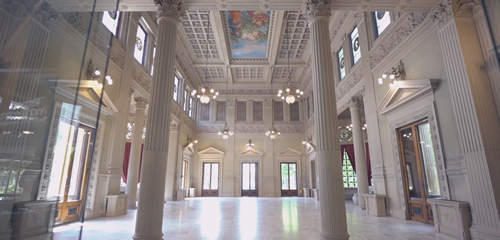Excelsior Thermal Complex
Viale Giuseppe Verdi, 63, 51016 Montecatini Terme, PT, Italia
Thermae
Description
Around the town hall building, there are buildings constructed or reworked in the early 1900s, enriched by elegant decorations, reflecting the floral taste that characterized the end of the 1800s and the first two decades of the 1900s. On the corner with Viale Manzoni stands the Excelsior Cinema, built in 1922 by Ugo Giovannozzi, which represents perhaps the most faithful testament to the dictates of European Liberty with the protruding iron and glass roof and the interesting choice of the curved porticoed façade.
Historical Notes
On the opposite side of Viale Verdi, the Tamerici Pavilion is still recognizable in its characteristic architectural structure, designed in 1903 by Giulio Bernardini as a kiosk for the sale of salts extracted from the Tamerici spring waters. On the left side, the shop of the "Arte della Ceramica" manufacturing, founded in Florence in 1896 by Galileo Chini, was housed in the building. The pavilion is decorated at the top with cherubs and floral interweavings, probably the work of the almost unreadable Chini, and on the façade by the four bas-reliefs in modeled grès by Domenico Trentacoste for the Chini Manufacturing stand set up on the occasion of the International Exhibition of Decorative Arts in Turin in 1902. Among the figures represented in the panels, inspired by ceramic processing, the same Galileo Chini is recognizable, who thoughtfully listens to the voices of three Muses. In front, the Excelsior Plant is introduced by an elegant triangular garden, which houses the "Fountain of Swans" by the sculptor Pirro Bianchi and on which the Renaissance-style loggia overlooks.
The oldest body of the building, designed by the architect Giulio Bernardini for use as a Municipal Casino and Grand Café, dates back to 1907 and preserves the charm of the architecture of the time intact. It was then used for the dispensing of thermal waters in the winter period and expanded by Ugo Giovannozzi in 1915 to allow its use as a thermal establishment. The rear body was demolished and replaced in 1968 by a modern and functional structure, articulated on four floors, dedicated to the innovative wellness programs of the Montecatini Spa.
The "liberty hall", skillfully connected to the modern part, is mainly used for conferences, exhibitions, and concerts. The two lateral exedrae, closed by artistic stained-glass windows interspersed with Corinthian columns, still house the old dispensing benches, currently carried out in the main hall. The tempera mural on the ceiling is the work of Ernesto Bellandi. In the sixteen windows that define the upper perimeter of the hall, the coats of arms of ancient Tuscan municipalities are represented with colored glass; below runs a delicate stucco frieze with putti and festoons bas-reliefs. Along the elegant external loggia, eight enameled terracotta medallions are inserted, depicting illustrious figures from the history of Montecatini. A little further on, there are the eighteenth-century Leopoldine Baths, almost completely transformed by the intervention of Ugo Giovannozzi between 1922 and 1926 and currently under renovation.
Modalità di accesso
Access to the Excelsior Thermal Complex is currently not allowed, as the facility is closed from May through October.
However, the building is easily visible externally and can be reached from Viale Giuseppe Verdi No. 63 where the establishment is located.
From April 1st, with the entry into force of Decree Law No. 24 of 24.03.22, possession of the "Green Pass" is no longer required to access public places;
Currently, the use of masks is not mandatory.
Access conditions: Presence of architectural barriers
Contacts
Public timetable
Not open at the moment
Related content
You may also like












